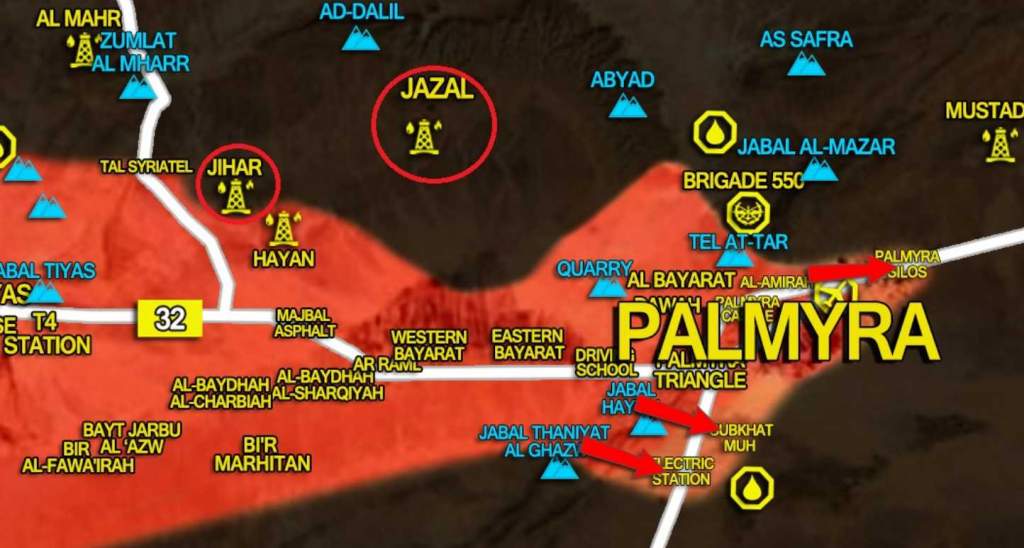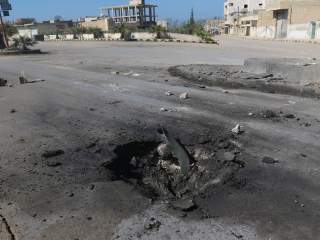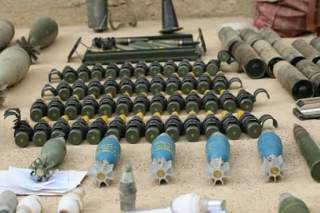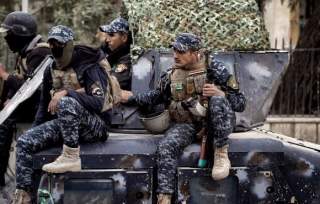

by Jim W. Dean, VT Editor … with New Eastern Outlook, Moscow

[ Note: Since I sent this article in to NEO a week ago, we have had the incredible situation develop where we had reports yesterday of the US coalition not only bombing a Syrian convoy 30-km from one of its militia bases at the al-Tanh crossing into Iraq, but also bombing an Iraqi Popular Military convoy approaching the same crossing from the east.
So we have the US using the “deconfliction” agreement to spread US and British Special Ops people among their militants, or among ISIS people pretending to be militants, while they are pretending to clear the border area of ISIS, so it can then attack any Syria forces wanting to approach their own border in “defense of their own forces”.
While the US coalition has pulled combat forces, including very questionable ones into Syria, under the guise of opposing ISIS, it seems it does not want the Syrians to be able to utilize the services of the 100,000-strong PMU Militias to do the same, despite their proven record of fighting ISIS. Imagine that.
One might actually get the idea that the US coalition does not want ISIS in Deir Ezzor being attacked by the PMU from the rear on the Iraqi side, which might put that fertile river basin under Damascus control. Even Lavrov spoke out against the US attacks today, so we will wait and see what the Russians do about them.
I had a premonition when I wrote this article, that despite the hard-fought success that Damascus has had in turning the war around, powerful forces were still in place and in play to snatch it away, if they see an opening to do so. I sense a game of chicken being played here that could have dangerous consequences.
Is the US baiting Assad or even the Russians to respond? We may find out by what happens this summer, or maybe not, and hence my title above, as predicting what will happen in Syria is risky game… JD ]
Jim’s Notes are solely crowdfunded via PayPal – JimWDean@aol.com
This includes research, needed field trips, Heritage TV Legacy archiving, and more – Thanks for helping out
*

– First published … May 19, 2017 –
“It is forbidden to kill; therefore all murderers are punished unless they kill in large numbers and to the sound of trumpets.” ― Voltaire
The news on the details of the fourth Astana meeting Safe Zones has been slow in coming, which is no surprise. The initial agreement was clearly a general one, with all the details left to the respective military staffs to complete.
We anticipated many hurdles during the month agreed upon for completing the militant group separation maps, checkpoints, civilian traffic flow, and humanitarian aid logistics planning.

I have just watched an excellent video of a brave undercover video team that went into Idlib on two trips and gathered a huge amount of information that I highly recommend watching. The biggest revelation was that the opposition forces are definitely a minority, and under virtual control of al-Nusra.
The video producer’s checkpoint map showed only two FSA checkpoints in the entire province, with the vast majority of them being al-Nusra checkpoints.
From what I could see, there were not enough opposition areas to really bother with separating, until you get into the northern part of the province filled with Turkmen and a lot of the Central Asian jihadis that even brought their families with them, enjoying the homes of former Christians and Damascus supporters.
Turkey will pretend it does not see or know anything about them, despite there being thousands living in the open, rotating in and out of the battle lines as ethnic jihadi units. So it is going to take a magician to come up with some realistic “borders” between the groups who have really been blended together, with some even invisible, to the Turks anyway.
But the war has not stopped to wait for a final Astana4 separation package to be delivered. Damascus cannot afford to wait for anything when Turkey, the US, Israel, Qatar and Saudi Arabia have a combination of their own troops and mercenaries operating inside Syria, with the goal of holding as much ground as possible before a political solution is hammered out.

Before the ink was dry on the Astana4 agreement, Damascus was redeploying its best offensive forces away from the Hama fighting, initially sending the Tiger brigade to Palmyra to widen the buffer around the city and to begin staging for a major thrust toward Deir Ezzor.
It seems the emerging Syrian strategy was that, with the US and SDF-YPG Kurds preparing for the big push to take Raqqa, the SAA wanted to move east on the M-20 road to relieve the entrenched Syrian forces at the Deir Ezzor airport.
This attack would prevent reinforcements being fed into Raqqa, where we have had reports of their flowing in to the city via the open southern flank. On its face, this would seem to be taking a lot of precious Syrian forces to the eastern part of the country, where they would be far away from any military crisis that might emerge on Syria’s many fighting flanks.
One of the biggest concerns is Turkey’s continued threats to take action against the Kurds, and US Secretary of Defense Mattis’ strange comment that he would find some way for the Turks to be involved in the Raqqa battle, which left military analysts baffled.
But there may be a method to this appearance of madness, with Assad spreading his fighting forces out to the eastern borders. There has been a stream of press statements from the Iraqi Shia Popular Militias (PMU) that, since Daesh was defeated in Mosul and its remnants hunted down in Western Iraq, the PMU saw their next strategic task as securing the Syrian border.

No details were given as to why, but the assumption was that they did not want fleeing ISIS fighters from Syria to feed highly experienced fighters into supporting a Daesh resurgence in Western Iraq.
It seems the Iraqis have learned the hard way that they never again want to leave their western border crossings open for an attack or smuggling weapons and supplies into the expected post-Mosul terror war that the Daesh survivors have threatened to carry on.
The Iraqi Popular Mobilization Militias number about 120,000, with strong backing from Iran financially, and with advisors and equipment.
In November of 2016 they announced that Iraq and Syria were planning to coordinate joint border security operations; it was clearly stated that if Syria asked for help fighting ISIS inside Syria, the militias were willing to do so. That would be a game changer.
We have an incredible situation developing in southern Syria, where the recent success in clearing thousands of opposition group fighters out of the Damascus suburbs has the SAA launching a push eastward to secure the al-Tanf border crossing into Iraq, just west of the eastern Jordan border.
US and British Special forces are reported to be north of the al-Tanf crossing in Homs province, supporting militant groups making their own push for control of Syrian border areas with Iraq. The SAA is engaging some of these opposition units east of Sewida in the mountains of al-Qasr and Rajm al-Dawla.
This could be a risky border control competition for the SAA, as the US has assembled an armored force in Jordan with US and Saudi troops that could quickly launch an attack toward Damascus with US coalition air support, and the Israelis of course, if they felt the need to threaten SAA successes in the south. But such a move could bring Russian and US-coalition air power into conflict at this delicate time, as the safe zones are being established.

As we look north into eastern Aleppo, we see that the SAA standoff with ISIS at the Jirah Military Airbase has ended with its capture and retreat by ISIS, which is expected to fight a delaying action to block the SAA from moving toward Raqqa. The town of Maskaneh is the last major held town in the area, and its capture would give the SAA wide open farmland country to push eastward to the rear of the SDF-YPG forces that have recently taken Tabqa, the city, airport and dam.
This is valuable, productive farmland along Lake Assad that Damascus would want to control close to Raqqa, with it being an historically Arab city, and therefore hard for the Kurds and their US backers to lay claim to. The city will be use as a bargaining chip in any future political settlement.
We will be watching how quickly the Mosul battle can be completed and the Iraqi Popular Militias deployed to the major Syrian border crossings. There would also be ongoing logistics commitments to keep them supplied for defensive and offensive fighting inside Syria.
For example, Assad might ask the PMU to open a rear attack on the Deir Ezzor front at the Resala crossing on the Euphrates, going up through al-Maydan, which is also valuable farmland.

Such a coordinated attack could demonstrate to other Mideast countries that these Western and Gulf States’ regime-change inspired terror wars can only be blocked by the combined resources of several countries. Syria and Iraq have paid a huge price in blood and carnage to have the trained military they have now.
Iran and Russia have filled in on the key areas where there was a critical need for air power, modern weapons and additional manpower, without which Damascus could have already fallen to the jihadis, and Baghdad was also intended to fall.
I share this in detail to give you a better perspective on why Assad and Russia wanted to get these safe zones in place and a solid ceasefire in place, to free up military resources to liberate more of Syria.
If the Popular Militias could be a major force for helping take and defend the east Syrian border area, that would free the SAA to redeploy back to the west to deal with future threats, for instance, from Turkey wanting to take up permanent residence inside Syria.
The Syrian War is far from over; and what Trump is going to do at any moment, we are all learning, is subject to change in a heartbeat. He will certainly be on display as he takes his first overseas tour, where I expect he will be telling everyone that he is going to do wonderful things, and maybe even part the Red Sea as a demonstration for us.
He is the living incarnation of the “loose cannon”, which creates a security risk to us all.
Jim W. Dean, managing editor for VT, producer/host of Heritage TV Atlanta, specially for the online magazine “New Eastern Outlook”.
*

Jim W. Dean is VT Editor Emeritus. He was an active editor on VT from 2010-2022. He was involved in operations, development, and writing, plus an active schedule of TV and radio interviews. He now writes and posts periodically for VT.
ATTENTION READERS
We See The World From All Sides and Want YOU To Be Fully InformedIn fact, intentional disinformation is a disgraceful scourge in media today. So to assuage any possible errant incorrect information posted herein, we strongly encourage you to seek corroboration from other non-VT sources before forming an educated opinion.
About VT - Policies & Disclosures - Comment Policy




Comments are closed.